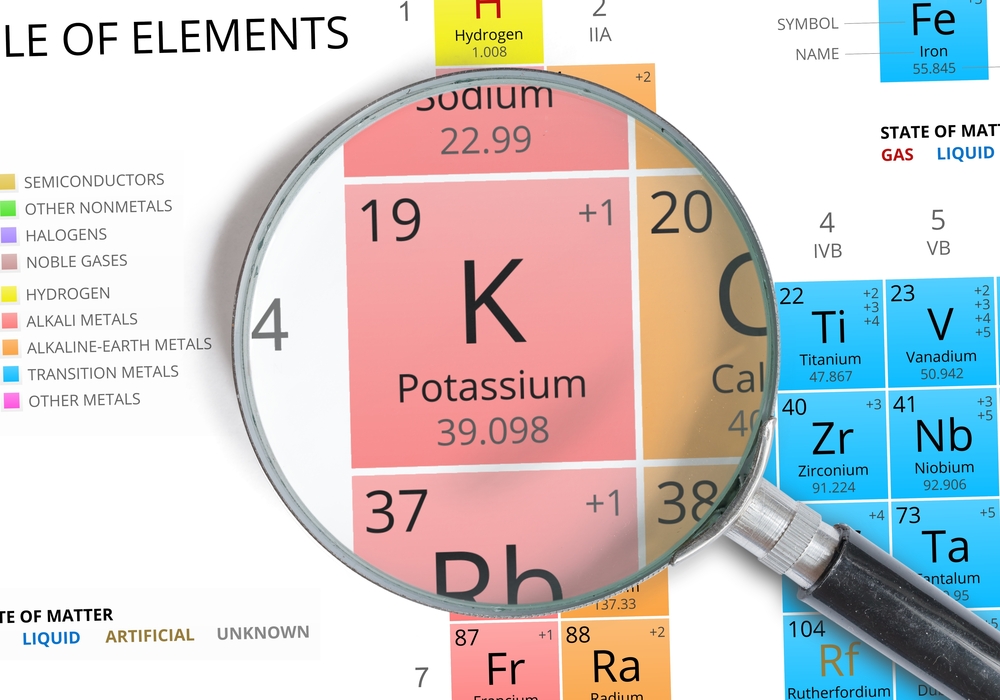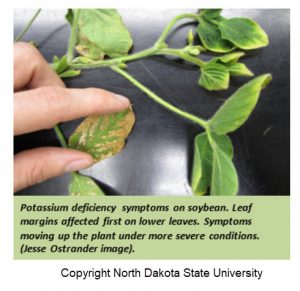
7 WAYS POTASSIUM PROMOTES HEALTHY CROPS
Potassium (K) is an essential mineral to all living things. In plants, potassium plays a key role in many processes central to healthy plant growth, and therefore, has an important impact on yield and quality.
Let’s look at the key plant functions that rely on potassium, followed by tips for identifying potassium deficiency through visual checks and tissue testing. These points have been adapted from a great article1 we came across the other day, and nicely sums up the role of potassium at a basic level.
1. Triggering enzyme activity responsible for growth
Enzymes are responsible for chemical reactions that are central to plant growth. Potassium is known to “activate” at least 60 enzymes that are central to the process. As well, K works to stabilize pH levels necessary to these enzymatic reactions at an optimum level between 7 and 8.
2.Efficient Use of Water/ Stress Resistance
Potassium regulates stomatal activity, by opening and closing the pores in the leaves. This is how a plant exchanges gasses (such as CO2, and O2 with the atmosphere). When K is present, the pores open. When it is removed, they close. In times where water levels are low, the plant will release K, which closes the stomates so the plant can retain more water. This helps protect the plant from the stress associated with drought.
3.Photosynthesis
Plants rely on a chemical called ATP (adenosine triphosphate), which provides energy necessary to photosynthesis. Potassium ions allow ATP to maintain an electrical charge. If a plant is deficient in K, this slows the rate of ATP production and affects the rate of photosynthesis.
Potassium can also help some plants actively position leaves to face towards – or away – from the sun to get more or less light. Again, this is another way it protects plants against stress.
4.Transportation of Sugar, Nutrients and Amino Acids
Sugar transportation and metabolism is vital to healthy fruit and grain development. ATP requires all the energy it can muster to transport the sugars produced by photosynthesis throughout the plant to assist in the process. When K is present, sugars flow freely. If there is a deficiency, fruit and grain development will suffer.
Potassium is also necessary to the translocation of nutrients, such as nitrates, phosphates, calcium, magnesium and amino acids.
5.Protein and Synthesis
Potassium is necessary to protein synthesis – producing the proteins and enzymes that regulate growth.
6.Achieving Balance Between Starch and Carbohydrates
In addition, potassium activates the enzyme required to synthesize starch, and prevents the accumulation of carbohydrates and nitrogen compounds.
7.Crop Quality
Ultimately, plants that have optimum potassium do better at harvest. It helps guard against disease. It also improves quality of grains and reduces lodging.
Tissue testing can identify K deficiencies
In broadleaf crops, potassium deficiency can be indicated by a burnt appearance on the leaves – particularly on older and lower leaves. It starts at the tip and works its way down. The reason lower leaves are affected is that available potassium is translocated to younger, actively growing leaves at the top. In canola, signs include stunted growth, smaller leaves and thinner stems. Lower leaves tend to brown around the edge and can fall off.
Tissue testing at the plant’s rapid growth stage can provide a good indicator of potassium levels in the plant. The N:K ratio, which is a key indicator on a standard tissue test, can identify if the plant is receiving a proper balance of nutrients. Tissue testing will determine the soil’s ability to supply the nutrients required for optimal production at peak demand. It can also identify if any supplemental potassium sources applied earlier in the season were accessible to the plant.
Ideally, you want to begin a tissue testing program at the start of the growing season and continue taking samples throughout the year. This improves your ability to interpret data, allows you to benchmark your progress, and provides a framework to better predict where nutrient levels are heading. An ongoing Plant Monitoring Program is even more valuable when done in conjunction with an upfront soil analysis that reveals availability of critical nutrients, including potassium. This is something worth considering for next year.
Addressing K deficiency in-season
We are just entering the summer months. As we learned, plants require potassium throughout the growing season, and it plays a particularly important role as your crop begins putting its energy into fruit and grain development.
If a potassium deficiency is identified, it is not too late in the season to address the situation through an in-crop application using a fertility product or a mid-season growth enhancement product that is rich in K. Consider a product that offers the benefits of immediate and slow release to take you through to the end of the season for a strong finish.
1 “Functions of Potassium in Plants.” Better Crops, Vol. 82, No. 3, 1998. Page 4-5.


